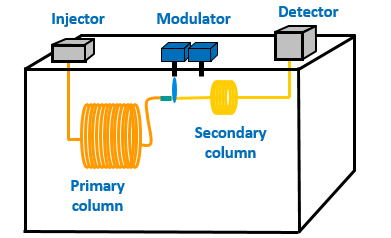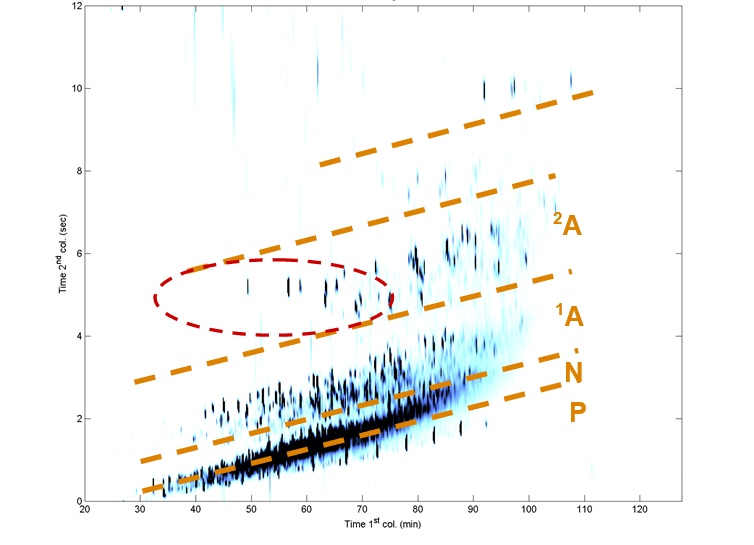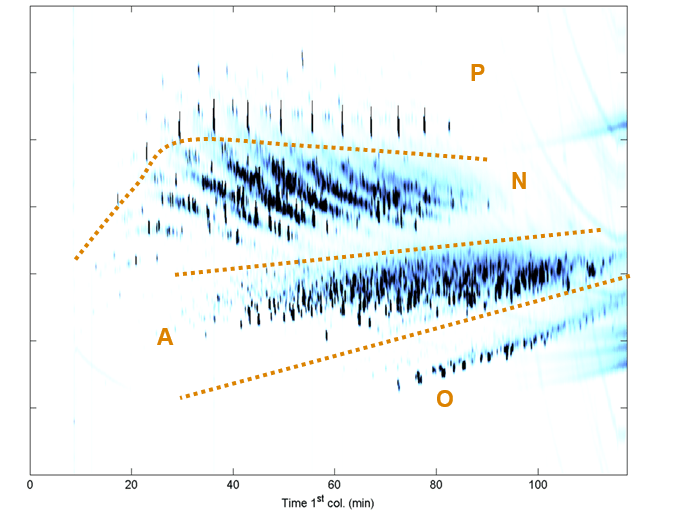Blog
What Is GCxGC? Comprehensive Two-Dimensional Gas Chromatography
Comprehensive two-dimensional gas chromatography, or GCxGC, and is a technique consisting of subjecting the whole sample to two dimensions of separations.
Posted on May 10, 2018
Guest Author: Badaoui Omais, Ph.D.
What is GCxGC?
Comprehensive two-dimensional gas chromatography, or GCxGC was created by Professor Phillips in 1991. From that date, it has extensively been applied to many kind of applications: fuel, forensics, food and flavour, environmental, metabolomics, biomarkers, and clinical. This revolutionary technique consists in subjecting the whole sample to two dimensions of separations. Each fraction collected after the first separation will be further separated in a column involving a different separation mechanism. The transfer of the fractions is done thanks to a modulation device (modulator) which traps, focuses and reinjects them in the secondary column. This leads to a 2D chromatogram offering higher peak capacity and more separation power. The figure below shows an example of a peak, which results from three coeluted compounds. After modulation, the peak is divided into 8 small fractions, which are subjected to a very fast separation in the second dimension. In fact, as this is a continuous process, the secondary separation must happen faster than the modulation time. Therefore, if an 80 second peak is modulated into 8 fractions, the modulation period would be 10s and the secondary separation must happen within these 10s. The second-dimension chromatograms are then stacked side-by-side and software offers a 2D contour plot visualisation and often a 3D visualization.Figure 1. 2D-GC principle: Adahchour, M., Beens, J.; Vreuls, R.J.J., Brinkman, U.A.Th. Recent developments in comprehensive two-dimensional gas chromatography (GCxGC) I. Introduction and instrumental set-up. Trends Anal. Chem., 25(5), 438-454 (2006)
 GCxGC Instrumentation
GCxGC Instrumentation
A GCxGC system looks like a conventional GC system. The main difference is the presence of a modulation device in the oven. As shown in Figure 2, the primary column is connected to the injector and the modulator, and the secondary one to the modulation and the detector. The first column is often 10 to 60 meters long and the second column must be shorter to allow fast separation. It is not rare to see 0.5 to 5m columns installed as second dimension.
Figure 2. 2D-GC instrumentation - LC.GC Europe 2011 (24) p. 352-365 by Omais et al.

GCxGC Modulation
Thermal modulation is the most frequent one. Cryogenic liquid nitrogen is used to trap the molecules eluting from the first dimension. When the first jet immobilizes the compounds during the modulation period, the molecules previously immobilized by the second jet can flow in the second column and be separated. Closed Cycle Refrigerated Loop Modulation is also widespread and does not require liquid nitrogen for thermal modulation. The closed cycle refrigerator/heat exchanger to produce -90°C at the jet.GCxGC Columns Set
The original column sets in the beginning were mainly PDMS (ZB-1 and ZB-5) in the first dimension and more polar columns in the second dimension, such as PEG (ZB-WAX) of 50%Phenyle-50%PDMS (ZB-50). These so called straight phase column sets are very suitable for hydrocarbon analysis. Therefore, these are still used most frequently in the oil and gas industry. The reverse configuration column set typically demonstrates the ability to provide more resolution for the polar compounds.1 The first-dimension column in this case is a polar column, followed by a mid-polar second dimension column. For each application there can be an optimal column set. Literature shows for example a ZB-WAX x ZB-1 column set to characterize polar phenolic compounds in hydrocarbon matrices. Depending on the sample and the goal, many different column sets can be used and the commercially available phases and dimensions offer a very wide range of opportunities.GCxGC Detectors
Considering the very fast secondary separation using a very short column, eluting peaks are very narrow involving an exceptionally fast data acquisition. Depending on the goal of the detection, the following can be used as long their acquisition frequency is set to adapt to generate enough acquisition points per peak:- Flame ionization detector (FID),
- (micro) electron capture detector (µECD)
- Mass spectrometry detectors such as fast time of flight (TOF/MS).
GCxGC Application
Figures 3 and 4 show the separation of a direct coal liquefaction gasoil cut (close to petroleum gasoil). Depending on the selected column set, the GCxGC chromatograms will be structured completely differently offering different separation options to the user.Figure 3. Gasoil – 100% PDMS x PEG 1A= Monoaromatics, 2A= Di-aromatics, 3A= Tri-aromatics, N=Naphthenes - B. Omais et al., Journal of chromatography A (2011), V.1226. 61-70

Figure 4. Gasoil – PEG x Trifluoropropyl, A= Aromatics, N= Naphtenes, O= Oxygenates - B. Omais et al., Analytical Chemistry (2012), V.83. 7550-7554
 Conclusion
2D-GC is a very promising technique for characterization of very complex matrices. In case of heavier compounds, recent columns resistant to high temperatures can provide great results. This is the case of the ZB-1HT x ZB-35 HT column sets, which are adapted for heavy oils.
Moreover, if high capacity is needed but compounds are not volatile, 2D-LC is a great option.
To finish with, in case the peak capacity of 2D-GC is not enough, an additional dimension of separation involving SFC can still be hyphenated upfront (SFC-GCxGC).
Download our real-life GCxGC application: Optimized Column Selectivity for Orthogonal Separation of FAMES Using GCxGC
For more information on GCxGC or anything mentioned above, reach out through our Live Chat and speak with a Technical Expert nearly 24/7 globally.
Conclusion
2D-GC is a very promising technique for characterization of very complex matrices. In case of heavier compounds, recent columns resistant to high temperatures can provide great results. This is the case of the ZB-1HT x ZB-35 HT column sets, which are adapted for heavy oils.
Moreover, if high capacity is needed but compounds are not volatile, 2D-LC is a great option.
To finish with, in case the peak capacity of 2D-GC is not enough, an additional dimension of separation involving SFC can still be hyphenated upfront (SFC-GCxGC).
Download our real-life GCxGC application: Optimized Column Selectivity for Orthogonal Separation of FAMES Using GCxGC
For more information on GCxGC or anything mentioned above, reach out through our Live Chat and speak with a Technical Expert nearly 24/7 globally.
-
B. Omais et al., Journal of chromatography A (2011), V.218. 3233-3240.














